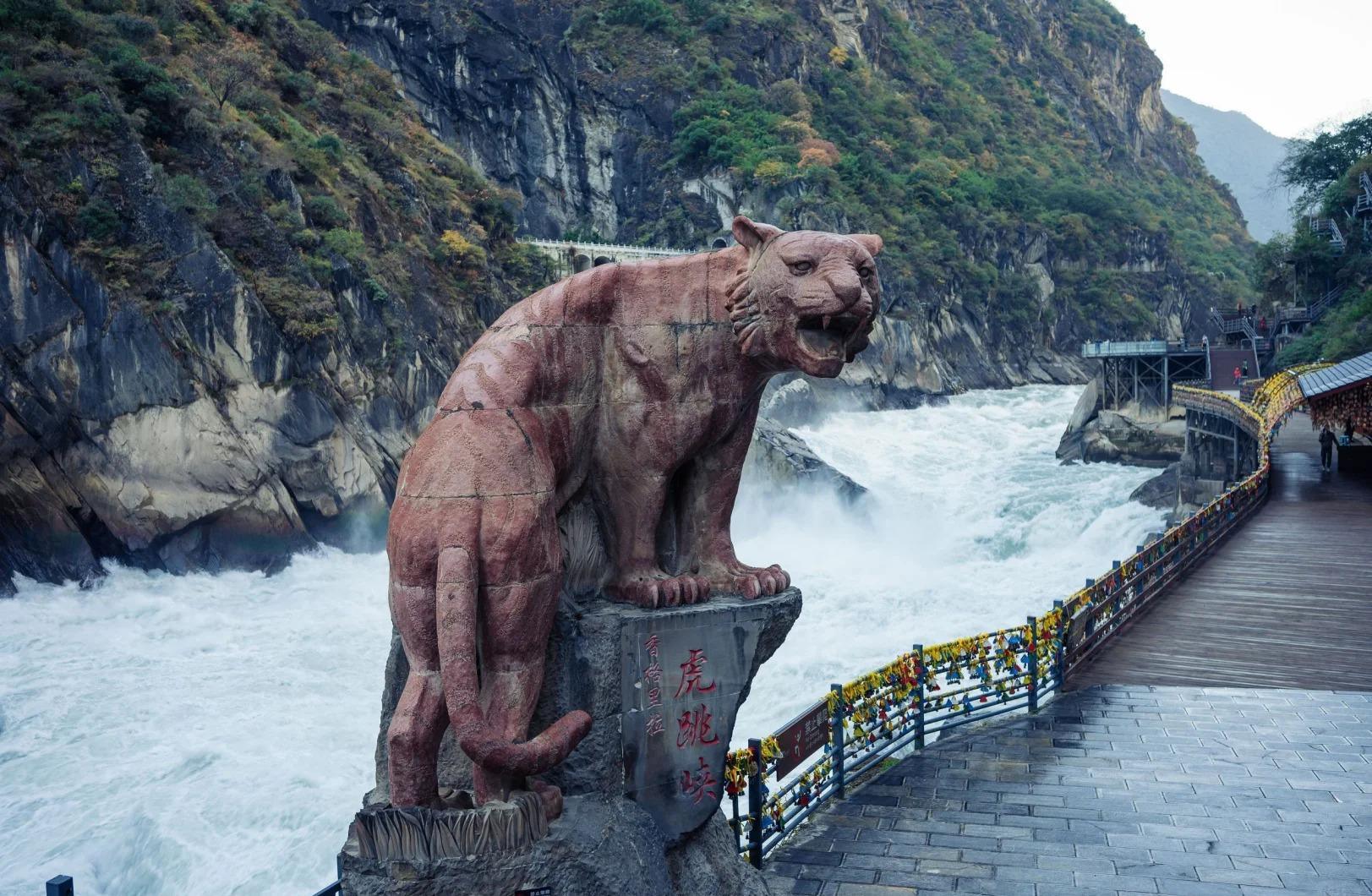Visiting Information
| Information | Details |
|---|---|
| Chinese Name | 虎跳峡 (Hǔtiào Xiá) |
| Location and Address | Shangri-La County, Diqing Tibetan Autonomous Prefecture, Yunnan Province, China |
| Opening Hours | Open 24 hours |
| Entrance Fee | 65 CNY (approximately 10 USD) |
| How to Get There | By Bus: Take a bus from Lijiang to Qiaotou (2 hours) By Taxi: Hire a taxi from Lijiang (2.5 hours) Note: There is no metro service to Tiger Leaping Gorge |
| Best Time for Visit | April to May and September to October |
| Contact Info | +86 887 8896531 |
Overview
Tiger Leaping Gorge is one of the deepest and most spectacular river canyons in the world. Located in Yunnan Province, China, it is part of the Three Parallel Rivers of Yunnan Protected Areas, a UNESCO World Heritage Site. The gorge is approximately 15 kilometers long and reaches a maximum depth of 3,790 meters from river to mountain peak.
Historical Background
The gorge gets its name from a legend that tells of a tiger that leapt across the narrowest part of the gorge to escape from a hunter. The area has been inhabited by various ethnic groups, including the Naxi, for centuries. In recent decades, it has become a popular destination for hiking and trekking, attracting visitors from around the world.

Architectural Features
- Hiking Trails: The main feature of Tiger Leaping Gorge is its hiking trail system. The most famous is the Upper Trail, also known as the High Trail, which runs along the northern side of the gorge and offers stunning views of the canyon and surrounding mountains.
- Suspension Bridges: Several suspension bridges span the narrower parts of the gorge, providing thrilling crossing points for hikers and offering spectacular views of the rushing waters below.
- Guesthouses: Along the hiking trails, there are numerous traditional guesthouses built in local architectural styles, providing accommodation and rest points for trekkers.
- Tiger Leaping Stone: At the narrowest point of the gorge, there’s a large rock in the middle of the river known as the Tiger Leaping Stone, from which the gorge gets its name.
Cultural Importance
Tiger Leaping Gorge holds significant cultural importance for the local Naxi people and other ethnic minorities in the region. It’s not only a natural wonder but also a place steeped in local legends and traditions. The gorge and its surrounding areas have been home to these communities for generations, and their cultural practices and way of life are closely tied to this dramatic landscape.
Surrounding Attractions
- Lijiang Old Town: Located about 60 kilometers from Tiger Leaping Gorge, Lijiang Old Town is a UNESCO World Heritage site known for its well-preserved ancient architecture, canals, and bridges. It offers a glimpse into the rich history and culture of the Naxi people.
- Jade Dragon Snow Mountain: This majestic mountain range is visible from many points along the Tiger Leaping Gorge trek. It’s a sacred mountain for the Naxi people and offers various activities like cable car rides and impressive cultural shows.
- Shangri-La (Zhongdian): Located north of the gorge, Shangri-La is a Tibetan town famous for its stunning Ganden Sumtseling Monastery, often referred to as the “Little Potala Palace.” It offers visitors a taste of Tibetan culture and beautiful high-altitude landscapes.

Photography Opportunities
- Panoramic Views: The High Trail offers numerous vantage points for capturing breathtaking panoramic views of the gorge, the Jinsha River, and the surrounding snow-capped mountains, especially during sunrise and sunset.
- Water Features: The rushing waters of the Jinsha River provide dynamic subjects for photography, particularly at the narrowest points of the gorge where the water’s power is most evident.
- Local Culture: The trek through Tiger Leaping Gorge offers opportunities to photograph local Naxi people, traditional guesthouses, and terraced farmlands, providing a glimpse into the area’s rich cultural heritage.
Modern Importance
- Eco-tourism: Tiger Leaping Gorge has become a model for sustainable eco-tourism in China, balancing environmental conservation with tourism development. It provides economic opportunities for local communities while preserving the natural landscape.
- Biodiversity Conservation: As part of the Three Parallel Rivers of Yunnan Protected Areas, the gorge plays a crucial role in preserving the region’s rich biodiversity, including numerous rare and endangered species of plants and animals.
- Cultural Preservation: The growing tourism industry around Tiger Leaping Gorge has helped to preserve and promote the cultural heritage of local ethnic minorities, particularly the Naxi people.
- Scientific Research: The unique geological features and ecosystems of Tiger Leaping Gorge make it an important site for scientific research in fields such as geology, hydrology, and ecology.

FAQ
- What is Tiger Leaping Gorge famous for?
Tiger Leaping Gorge is famous for being one of the deepest and most spectacular river canyons in the world, its challenging hiking trails, breathtaking scenery, and the legend of a tiger leaping across the narrowest part of the gorge. - What’s inside Tiger Leaping Gorge?
Inside Tiger Leaping Gorge, you’ll find dramatic cliffs, the rushing Jinsha River, hiking trails (including the famous High Trail), traditional guesthouses, local villages, and stunning views of surrounding mountains including Jade Dragon Snow Mountain. - Is Tiger Leaping Gorge free?
No, Tiger Leaping Gorge is not free. There is an entrance fee of 65 CNY (approximately 10 USD) to access the gorge area. - Is Tiger Leaping Gorge worth visiting?
Yes, Tiger Leaping Gorge is definitely worth visiting. It offers spectacular natural scenery, challenging hikes, cultural experiences, and is considered one of the most beautiful treks in China. - What to do in Tiger Leaping Gorge?
In Tiger Leaping Gorge, you can hike the famous trails, enjoy stunning views, visit local Naxi villages, stay in traditional guesthouses, photograph the dramatic landscape, and experience the power of the Jinsha River at the gorge’s narrowest points. - How do I get to Tiger Leaping Gorge in the local city?
To get to Tiger Leaping Gorge from Lijiang (the nearest major city), you can take a bus from Lijiang to Qiaotou, which takes about 2 hours. Alternatively, you can hire a taxi from Lijiang, which takes about 2.5 hours. - How to visit Tiger Leaping Gorge?
To visit Tiger Leaping Gorge, plan a trek of 2-3 days for the full experience. Start from Qiaotou, hike the High Trail, stay in guesthouses along the way, and end at Tina’s Guesthouse or continue to Daju. Alternatively, for a shorter visit, you can take a day trip to view the gorge from designated viewpoints accessible by car.



